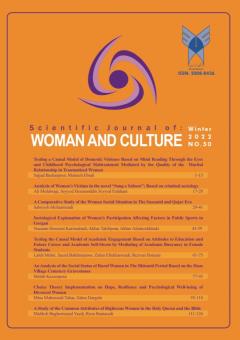تحلیلی بر جایگاه اجتماعی زنان روستایی دوره ایلخانی براساس نقش مایه سنگمزارات گورستان روستای هاس
الموضوعات :
1 - دانشگاه هنر اسلامی تبریز، گروه باستانشناسی، تبریز، ایران.
الکلمات المفتاحية: گورستان هاس, دوره ایلخانی, زنان روستایی, نقش مایه سنگ مزارات,
ملخص المقالة :
هدف پژوهش حاضر تحلیلی بر جایگاه اجتماعی زنان روستایی دوره ایلخانی براساس نقش مایه سنگ مزارات گورستان روستای هاس می باشد. جهت انجام این پژوهش تعداد 200 سنگ مزار سالم بود که به روش نمونه گیری غیر احتمالی تعداد 20 نمونه سنگ مزاراتی که دارای بیشترین اطلاعات در خصوص حرفه زنان بوده اند، در این پژوهش انتخاب و مورد مطالعه قرار گرفتند. این پژوهش از نوع هدف، کیفی است و روش انجام آن از نوع توصیفی-تحلیلی است. جهت دستیابی به داده های این مطالعه، در مرحله اولیه براساس مطالعات میدانی، مستندنگاری های لازم از قبیل عکاسی، طراحی و خوانش کتیبه ها و نقوش صورت پذیرفت. پس از ارائه توصیفات واطلاعات کتابخانه ای به روش تحلیلی داده ها مورد بررسی قرار گرفتند. نتایج نشان داد که، با ورود مغولان به ایران، وضعیت زنان دگرگون شد و آنان توانستند آزادانه تر در کنار مردان در امور گوناگون جامعه به ایفای نقش بپردازند. منابع تاریخی و هم چنین شواهد هنری، جایگاه برجستۀ زنان درباری (به ویژه خاتون ها) در مناسبات سیاسی و اجتماعی را به نمایش گذاشته و در خصوص زنان روستایی این دوره، اطلاعاتی در دست نبود. این در حالی است که روی سنگ مزارات گورستان هاس، زنان و مردان روستایی به نمایش درآمده اند که در طول حیات خود، در یک جایگاه اجتماعی هر کدام به یک شغلی مشغول بوده اند و متناسب با حرفه خود جایگاه اجتماعی را کسب می کرده اند. این امر از جنس و ابعاد سنگ مزارات، تکنیک هنری، کتیبه ها، نقش مایه ها و هم چنین اشیاء روی سنگ مزارت قابل تشخیص بود. مردان حرفه هایی مانند کشاورز، دامدار، شکارورز، نوازنده و خدمتکار و زنان ورنی بافی را که در اقتصاد معیشتی جامعه آن دوره نقشی بارز را ایفا نموده اند از جایگاهی هم پای مردان برخوردار بوده اند.
Abdi, S., Basam, S. J. A., & Mirzayi, A. (2016). Design and mutif analysis in contemporary rural carpets in Ahar city. Goljam, 11(27), 77-97. URL: https://goljaam.icsa.ir/article-1-206-fa.html
Ajhand, Y. (2010). Interaction of Iranian, Islamic and Turkish cultures in Shiraz (8th and 9th centuries). Iranian History, 6(1), 15-1. [Persian] URL: https://www.sid.ir/fa/journal/ViewPaper.aspx?ID=135686.
Bayani, Sh. (2010). Women in the Monghol Period. Teharn: Tehran University publication. [Persian] URL: https://www.gisoom.com/book/1611028
Basam, S. J. A., Zarye Zahra, S. A. A., & Farjou, M. H. (2007). Dream of Heaven: The Art of Iranian Carpet Weaving, Tehran: For 14. [Persian] URL: https://www.gisoom.com/book/1317493//
Dousti, H. (1995). History and geography of Arasbaran. Tehran: Ahrar. [Persian] URL: https://www.gisoom.com/book/168928
Daneshgar, A. (1998). Comprehensive culture of memorial carpet "Encyclopedia of Iran". Tehran: Asadi Memorial. [Persian] URL: http://fipak.areeo.ac.ir/site/catalogue/18454148
Seyed Sadr, S. A. Gh. (2019). Encyclopedia of handicrafts and related letters. Tehran: Simaye Danesh. [Persian] URL: https://www.gisoom.com/book/11109013
Farokhi, Y. (2015). Research on women (Ermuk) in the formation of the Mongol army. Social History Research, 4(1), 129-107. [Persian] URL: https://civilica.com/doc/795839/
Jamali, B., Hasani, M, M., & Behrouzi, M. (2021). The social status of women in the Sassanid period (based on seals and the effect of seals). Islamic Art Journal, 39(1), 70-56. [Persian] URL: http://www.sysislamicartjournal.ir/article_120671.html
Karoubi, A., & Fayaz Anoush, A. (2017). Historical study of women's clothing in the Ilkhanate period (736- 654 AH). Journal of Post-Islamic Iranian History, 7(2), 161 189. [Persian] URL: https://www.sid.ir/fa/journal/ViewPaper.aspx?id=321931
Kazempour, M., Omrani, B., & Rezalou, R. (2013). A new approach to the large stone tombs of East Azerbaijan based on the findings of the Zardkhaneh area. Archaeological Study, 4(1), 74-55. [Persian] URL: https://www.sid.ir/fa/journal/ViewPaper.aspx?ID=265967
Kazempour, M., & Shokrpour, Sh. (2021). A symbolic analysis of the Islamic Period Gravestones in the Ahar Museum. International Journal of Historical Archaeology, 25(1), 1065-1086. URL: https://link.springer.com/article/10.1007/s10761-021-00588-6
Karoubi, A., & Fayaz Anoush, A, H. (2017). Historical study of women's clothing in the Ilkhanate period (736-654 AH). Iranian of Islamic Period History, 13(1), 161-183. [Persian] URL: https://www.sid.ir/fa/journal/ViewPaper.aspx?id=321931
Malekzadeh, E. (2009). The political, social and cultural situation of women in the Mongol and patriarchal periods. Maskouyeh, 4(2), 206-167. [Persian] URL: https://www.sid.ir/fa/Journal/ViewPaper.aspx?ID=214027
Polo, M. (1257). Travelogue. Translated by Habib olah Sahihi. (1972). Tehran: Book Translation and Publishing Company Publications. [Persian] URL: https://taaghche.com/book/18111
Mesbah Ardekani, N. M., & Dadvar, A. (2009). The mufti of the female on Iranian seals from the pre-linear period to the end of the Sassanid period. Women in Development and Politics Journal, 4(1), 161-184. [Persian] URL: https://www.sid.ir/fa/journal/ViewPaper.aspx?id=85159
Mohammadi, S. (2016). Investigating the structure of design and role from the aesthetic point of view of Dorney Ardabil. National Conference of Handmade Carpets, South Khorasan Birjand University. [Persian] URL: https://www.sid.ir/fa/seminar/ViewPaper.aspx?ID=55257
Nourolahi, A., Talayi, H., & Firouzmandi, B. (2016). The position of women in the Iron Age based on archeological studies among the nomads of the western Central Zagros. Woman in Culture and Art, 1(2), 107-120. [Persian] URL: https://www.sid.ir/fa/journal/ViewPaper.aspx?id=279491
Sharad, E. (2015) Women of the Great Mongolian Shahnameh (Analysis of the role and position of women in the Great Mongolian Shahnameh with a Baztab approach). Women in Culture and Art, 3(1), 391-408. [Persian] URL: https://journal.ut.ac.ir/article_54518.html
Shirkhani, M. R., Ahikhteh, F., & Ahikhteh, T. (2017). A study of the social status of women among the literary texts of ancient Iran and the pre-Islamic Arabs. Exploration of Comparative Literature, 6(22), 89-114. [Persian] URL: https://www.sid.ir/fa/journal/ViewPaper.aspx?ID=281121
Talebi, Y. (2010). Reflection of the position of women in patriarchal pottery motifs. Fine Art, 40(1), 63-70. [Persian] URL: https://www.sid.ir/fa/Journal/ViewPaper.aspx?id=113261
Yasini, S. R. (2015). A comparative study of the image of women in Persian literature and Iranian paintings. Women Studies, 10(1), 139-162. [Persian] URL: https://www.sid.ir/fa/Journal/ViewPaper.aspx?id=234027
_||_


